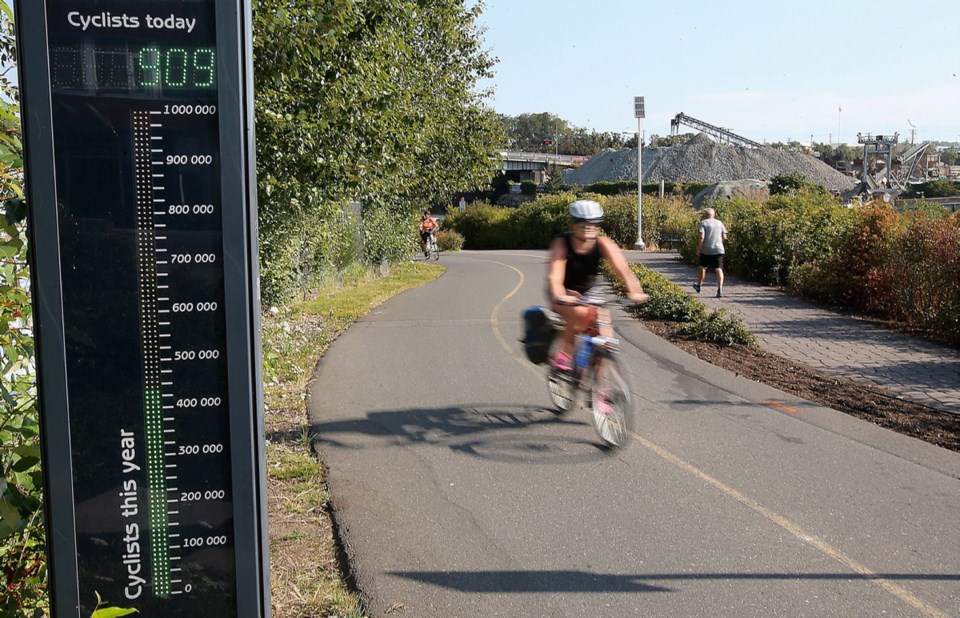The City of Victoria is receiving $750,000 for its initiatives aimed at cycling and pedestrian routes for people of all ages and abilities.
The funding, announced by the Federation of Canadian Municipalities and the federal government, is part of $31 million going to 27 initiatives across the country. The money comes through the Municipalities for Climate Innovation Program and the Green Municipal Fund.
“What they were really looking for was projects that reduce greenhouse-gas emissions and foster active transportation,” said Victoria Mayor Lisa Helps. “That was the impetus under which we applied.
“So we got three-quarters of a million dollars to be used to complete the Wharf-Humboldt-Vancouver corridor — so the end of our Phase 1 work.”
Phase 1 also includes bike lanes on Pandora Avenue, which cost $3.4 million, and Fort Street, which cost $3.27 million.
The bike lanes have been controversial, with complaints about loss of parking, not enough space for larger vehicles, and some businesses saying they lost significant money during construction.
“Thrilled to have yet another senior level of government invest in this project,” Helps said. “That brings the total grants we’ve received from senior levels of government up over $2.5 million for Phase 1.”
She said the Wharf-Humboldt-Vancouver corridor stands out because there are probably as many pedestrian improvements planned as there are improvements for cyclists. That makes it more of an “active-transportation” system than just a bike system, Helps said.
“At the corner of Humboldt and Government, where the tourist-information building is, there’ll be a new pedestrian plaza.” It will include trees and benches, Helps said.
“And then just down at Humboldt and Douglas, where it’s currently a five-way intersection, it will be a four-way intersection and there’ll be an even bigger public plaza there — with again street trees, benches, pedestrian improvements.”
The effort will be similar to what happened on Fort Street, where about half the money spent was for bike lanes and half for such things as sidewalks and trees, Helps said.
“Also on Vancouver Street there is a real opportunity to install benches.”
The only benches there now are at bus stops, she said.
“Vancouver Street is a beautiful pedestrian thoroughfare, so as part of the improvements we make for bikes there will also be more street furniture — benches and places for people to just stop and sit and be.”
The plan for bike lanes has clearly undergone a number changes, Helps said.
“It started off as Biketoria, then it became the Bike Network and I think now we’re broadening it even more as a complete active-transportation network,” she said. “There are benefits to everyone who’s walking or cycling.”
Greater Victoria Cycling Coalition spokesman Corey Burger said the grant is great news, and will be a big help along Wharf Street, especially, since it is one of the city’s busiest tourist thoroughfares.
“One of the things the bike lane is going to do is provide a really nice buffer between people walking on the sidewalk and the moving vehicles.”
Both the Pandora and Fort lanes have performed well and have been “a gamechanger” for cycling activity, Burger said. He said he sees more young people cycling on Pandora than ever before, and general use is also increasing.
“What we saw last year was there was about a 10 per cent lift once Pandora opened.”
The rise in numbers has continued, Burger said.
“What we’ve seen this year since Fort and especially the Johnson Street Bridge have opened, there’s been skyrocketing numbers,” he said. In the month after the bridge opened on March 31, the bike-counting mechanism nearby on Harbour Road, at the start of the Galloping Goose trail, went from 1,500 per day to 2,500 per day.
Burger said that each piece of the cycling network builds on the others.
“Once Wharf goes in, Wharf will connect to Fort,” he said. “Now we’re actually seeing the network that was envisioned three-and-a-half, four years ago.”
Burger said protected bike lanes eliminate common types of collisions with motor vehicles, including bikes getting rear-ended, sideswiped or hit by an opening vehicle door.



